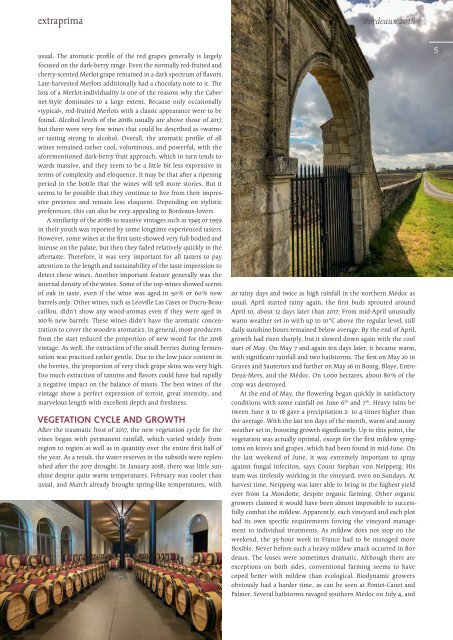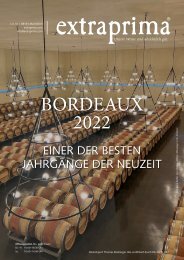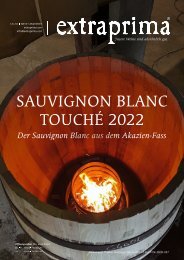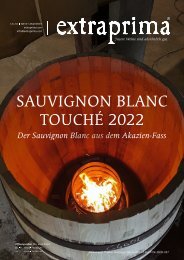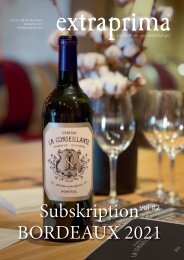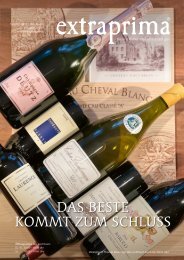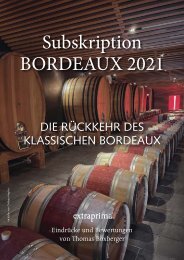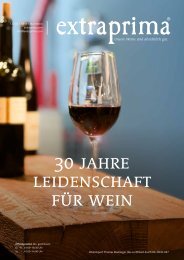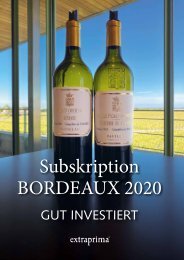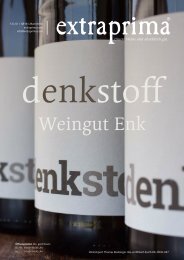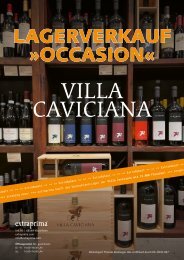You also want an ePaper? Increase the reach of your titles
YUMPU automatically turns print PDFs into web optimized ePapers that Google loves.
extraprima<br />
<strong>Bordeaux</strong><strong>2018</strong><br />
usual. The aromatic profile of the red grapes generally is largely<br />
focused on the dark-berry range. Even the normally red-fruited and<br />
cherry-scented Merlot grape remained in a dark spectrum of flavors.<br />
Late-harvested Merlots additionally had a chocolaty note to it. The<br />
loss of a Merlot-individuality is one of the reasons why the Cabernet-Style<br />
dominates to a large extent. Because only occasionally<br />
»typical«, red-fruited Merlots with a classic appearance were to be<br />
found. Alcohol levels of the <strong>2018</strong>s usually are above those of 2017,<br />
but there were very few wines that could be described as »warm«<br />
or tasting strong in alcohol. Overall, the aromatic profile of all<br />
wines remained rather cool, voluminous, and powerful, with the<br />
aforementioned dark-berry fruit approach, which in turn tends towards<br />
massive, and they seem to be a little bit less expressive in<br />
terms of complexity and eloquence. It may be that after a ripening<br />
period in the bottle that the wines will tell more stories. But it<br />
seems to be possible that they continue to live from their impressive<br />
presence and remain less eloquent. Depending on stylistic<br />
preferences, this can also be very appealing to <strong>Bordeaux</strong>-lovers.<br />
A similarity of the <strong>2018</strong>s to massive vintages such as 1945 or 1959<br />
in their youth was reported by some longtime experienced tasters.<br />
However, some wines at the first taste showed very full-bodied and<br />
intense on the palate, but then they faded relatively quickly in the<br />
aftertaste. Therefore, it was very important for all tasters to pay<br />
attention to the length and sustainability of the taste impression to<br />
detect these wines. Another important feature generally was the<br />
internal density of the wines. Some of the top-wines showed scents<br />
of oak in taste, even if the wine was aged in 50 % or 60 % new<br />
barrels only. Other wines, such as Léoville Las Cases or Ducru-Beaucaillou,<br />
didn’t show any wood-aromas even if they were aged in<br />
100 % new barrels. These wines didn’t have the aromatic concentration<br />
to cover the wooden aromatics. In general, most producers<br />
from the start reduced the proportion of new wood for the <strong>2018</strong><br />
vintage. As well, the extraction of the small berries during fermentation<br />
was practiced rather gentle. Due to the low juice content in<br />
the berries, the proportion of very thick grape skins was very high.<br />
Too much extraction of tannins and flavors could have had rapidly<br />
a negative impact on the balance of musts. The best wines of the<br />
vintage show a perfect expression of terroir, great intensity, and<br />
marvelous length with excellent depth and freshness.<br />
VEGETATION CYCLE AND GROWTH<br />
After the traumatic frost of 2017, the new vegetation cycle for the<br />
vines began with permanent rainfall, which varied widely from<br />
region to region as well as in quantity over the entire first half of<br />
the year. As a result, the water reserves in the subsoils were replenished<br />
after the 2017 drought. In January <strong>2018</strong>, there was little sunshine<br />
despite quite warm temperatures. February was cooler than<br />
usual, and March already brought spring-like temperatures, with<br />
20 rainy days and twice as high rainfall in the northern Médoc as<br />
usual. April started rainy again, the first buds sprouted around<br />
April 10, about 12 days later than 2017. From mid-April unusually<br />
warm weather set in with up to 10 °C above the regular level, still<br />
daily sunshine hours remained below average. By the end of April,<br />
growth had risen sharply, but it slowed down again with the cool<br />
start of May. On May 7 and again ten days later, it became warm,<br />
with significant rainfall and two hailstorms. The first on May 20 in<br />
Graves and Sauternes and further on May 26 in Bourg, Blaye, Entre-<br />
Deux-Mers, and the Médoc. On 1,000 hectares, about 80 % of the<br />
crop was destroyed.<br />
At the end of May, the flowering began quickly in satisfactory<br />
conditions with some rainfall on June 6 th and 7 th . Heavy rains between<br />
June 9 to 18 gave a precipitation 2- to 4-times higher than<br />
the average. With the last ten days of the month, warm and sunny<br />
weather set in, boosting growth significantly. Up to this point, the<br />
vegetation was actually optimal, except for the first mildew symptoms<br />
on leaves and grapes, which had been found in mid-June. On<br />
the last weekend of June, it was extremely important to spray<br />
against fungal infection, says Count Stephan von Neipperg. His<br />
team was tirelessly working in the vineyard, even on Sundays. At<br />
harvest time, Neipperg was later able to bring in the highest yield<br />
ever from La Mondotte, despite organic farming. Other organic<br />
growers claimed it would have been almost impossible to successfully<br />
combat the mildew. Apparently, each vineyard and each plot<br />
had its own specific requirements forcing the vineyard management<br />
to individual treatments. As mildew does not stop on the<br />
weekend, the 35-hour week in France had to be managed more<br />
flexible. Never before such a heavy mildew attack occurred in <strong>Bordeaux</strong>.<br />
The losses were sometimes dramatic. Although there are<br />
exceptions on both sides, conventional farming seems to have<br />
coped better with mildew than ecological. Biodynamic growers<br />
obviously had a harder time, as can be seen at Pontet-Canet and<br />
Palmer. Several hailstorms ravaged southern Médoc on July 4, and<br />
5


